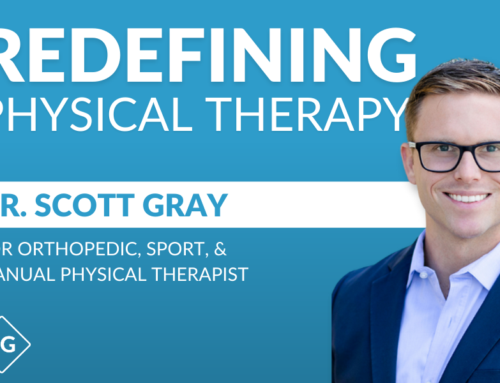Podcast: Play in new window | Download
Subscribe: Spotify | Amazon Music | RSS
Happy Friday everyone, and hope everyone’s week was great and that you guys have implemented some of the things that we’ve talked about over the last couple of weeks with your clients or patients.
But today I want us to talk about a case study of a patient I was treating, who was a golfer.
And he had come into the clinic with lower back pain. He was a right-handed golfer and he had back pain on his backswing, right?
And so anytime you treat a golfer, you really want to look at the three big areas, the thoracic spine, the hips, and the feet, right?
And so you need a ton of rotation in this sport.
And if you’re not getting rotation at the right places, you’re going to typically jam up the lower back in the facet joints and get lower back pain.
And so this individual was getting back pain on the left-hand side, on his backswing.
And if you know the mechanics of the spine, right, you’re going to be compressing there.
And so that’s really what was causing his back pain. But, I had cleared up his T spine, I cleared out his hips and all the different planes.
He even had good foot mobility, right?
And so I was like, kind of stumped. And I was thinking to myself, well, what am I missing?
And I started looking at his neck and this is something I had missed.
He was actually not getting enough cervical rotation back to the left.
And so as a result of that, he was trying to go back further and further to get a bigger backswing, but it was just further creating more and more pathology.
And he was further taking his eye off the ball because he didn’t have the relative left rotation of his subcranial spine.
So for those of you who know mechanics, right?
So if I rotate from my thoracic spine into my backswing, I need a relative.
If my eyes are still looking at the golf ball I need left rotation, whether that be mid-cervical, subcranial, upper thoracic, I need probably some rotation back to the left there.
And so I had checked his mid-cervical spine, which looked good.
I checked his CTJ, that looked good. So then I went to subcranial and it was a mess, right?
And so he was having a hard time being able to do a forward nod when you lay him down, right?
So that could be your AA not getting an anterior glide.
But then when I put him inside bending right and rotate him left with our AA test, he was locked up, right?
And so what I had found, actually it was on that right side of his subcranial spine. He wasn’t getting that anterior glide of his AA going forward.
And so it was really causing his golf game a bunch of problems, right?
And so the take-home lesson of today is like, you may have adequate mobility of the thoracic spine, the hips. You may have normal foot mobility, good strength and balance, and stability with a golfer.
But if they’re still not getting better, be sure to look up at the cervical spine, right?
So the cervical spine is powerful because it’s going to limit how much trunk rotation you can get at the T spine, right? And so it’s a very powerful concept, and I think sometimes as clinicians, we forget that whether it even be any of our clients that maybe are not golfers, it could be an athlete, a field sport athlete.
It could even just be in your typical 50 to 65 plus patient that has some back pain, but they get back then because they rotate primarily there, because they don’t have cervical mobility.
Whether that’d be looking behind them, looking up, down, you name it, but typically it’s rotation. But that’s my case study for today.
And so be sure to check the subcranial spine and mid-cervical spine.


